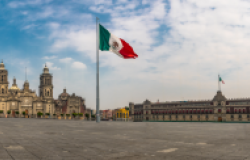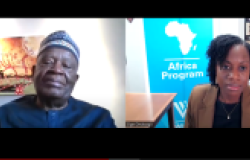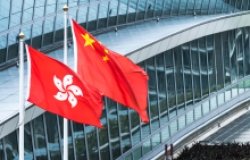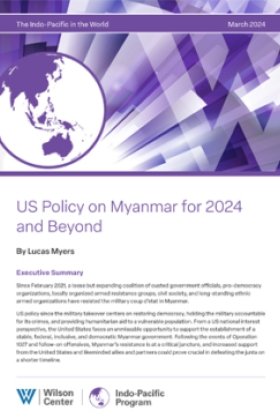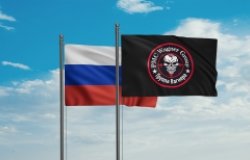'Latin America in 2010: Opportunities, Challenges and the Future of the U.S. Policy in the Hemisphere': Dr Cynthia Arnson Testifies before the US Senate Committee on Foreign Relations
Latin American Program Director Cynthia Arnson testified before the Senate Foreign Relations Committee Subcommittee on the Western Hemisphere at the December 1 hearing "Latin America in 2010: Opportunities, Challenges and the Future of the U.S. Policy in the Hemisphere." Read her testimony about major political and economic trends in the region, and the challenges they pose for U.S. policy.
Latin American Program Director Cynthia Arnson testified before the Senate Foreign Relations Committee Subcommittee on the Western Hemisphere at the December 1 hearing "Latin America in 2010: Opportunities, Challenges and the Future of the U.S. Policy in the Hemisphere." Her prepared remarks are here.
Mr. Chairman and Members of the Subcommittee:
I am honored to offer this testimony today, and especially honored to be included in the last session of this Subcommittee chaired by Senator Christopher Dodd. Senator Dodd has been a leading voice on Latin American issues within the Congress for many decades. His tireless efforts on behalf of democracy, human rights, and social justice have rightly earned him the respect and admiration of public officials and private citizens throughout the United States and the hemisphere.
My remarks will briefly address some of the major political and economic trends in Latin America and therefore the principal challenges for U.S. policy.
Disaggregate the Region
Over the last decade, it has become more and more difficult to conceive of, let alone implement, a one-size-fits-all U.S. policy for Latin America and the Caribbean. It is true that the sharp ideological divisions of the Cold War have receded. And leaders of the center-Left and center-Right have converged around a commitment to democratic practices, macroeconomic stability, as well as the belief that state has an important role to play in advancing social welfare.
At the same time, differences between and among countries and sub-regions are growing. These differences have to do with levels of economic development, wealth, human capital, and social cohesion; the strength of democratic institutions and adherence to the principles of representative democracy; and the density of relations with the United States.
For example, Brazil is now the world's eighth largest economy, and alone accounts for 40 percent of the entire region's GDP. Brazil's state-controlled oil company, Petrobras, is the world's fourth largest corporation (trailing only Exxon Mobil, Apple, and PetroChina). According to the World Bank, South America as a whole grew an average rate of 5-6 percent between 2004 and 2008, double the rate of U.S. growth in this same period; and this gap has only widened since the onset of the 2008 recession. Commodity- and agriculturally-rich countries such as Chile, Peru, and Argentina have grown robustly during a period of global recession, largely due to Chinese demand.
By contrast, the U.S. financial crisis of September 2008 has brought havoc to those countries most deeply integrated with the United States: Mexico, Central America, and the Caribbean. Mexico has begun to recover, but many smaller countries remain mired in recession. Mexico, Central America, and the Caribbean are densely linked to the United States due to patterns of trade, investment, remittances, and migration. Their proximity to drug consumption and other illegal markets in the United States has drawn us together in more perverse and destructive terms as well.
In the Andean region, it is hard to imagine countries more different in their political and economic orientations than Colombia and Venezuela, despite the recent warming of relations between these two neighbors. Colombia's economy is booming and foreign investment is at record levels while oil-rich Venezuela is the only country in South America whose economy is contracting. The so-called ALBA nations of Venezuela, Bolivia, Ecuador, and Nicaragua share similar patterns of hyper-presidentialism, autocracy, and authoritarianism. But there are also important differences among them, including the constituencies that constitute their core of support, and the strength, coherence, and broad-based appeal of their political opposition.
Thus, while it is appealing to speak of U.S policy in the Western Hemisphere, the truth is that diplomacy must take into account the variety among and between countries and sub-regions. The Obama administration's recognition of this diversity, and the more nuanced diplomacy required to meet it, represent an advance over previous decades.
Diminished Control or Diminished Influence?
As South American democracies have matured and deepened in the decades since the transition from authoritarian rule, leaders have sought to diversify foreign policy partners and to give priority to relationships beyond the United States. High levels of economic growth over the last ten years, coupled with social policies that have reduced poverty and expanded social cohesion, have created the conditions for the projection and exercise of "soft power" by many countries of the hemisphere. Some of this projection, particularly that exercised by Venezuela—is aimed explicitly at limiting or undermining U.S. influence in the region. Other manifestations of assertiveness and independence, however, reflect the increased economic and political capacity of stable democracies. Virtually all countries of the region, regardless of political orientation, have sought to expand their trading partners and political alliances.
In this environment, U.S. and Latin American interests will inevitably clash at times, as they did mightily when Brazil's President Lula attempted earlier this year to broker an agreement with Iran over that country's nuclear ambitions, in opposition to the United States as well as the major powers of the UN Security Council. In recent weeks, by agreeing to extradite accused drug trafficker Walid Makled to Venezuela rather than to the United States, Colombia demonstrated the priority it attaches to the relationship with its immediate neighbor, rather than Washington. Aggressive efforts by actors such as China, Russia, Iran, to expand their political, economic, and military relationships in the hemisphere are a reality and pose many challenges for U.S. interests. But U.S. power to control, let alone prevent, the diversification of Latin American foreign relations is limited and, in some cases, non-existent. Indeed, U.S. influence—something different from control—will be maximized to the extent the United States recognizes, accepts, and works to situate itself within the changed circumstances in the hemisphere. This is the normal functioning of diplomacy among allies, whose interests will converge some but not all of the time. The current administration's emphasis on multilateralism and partnership is promising in that it recognizes not only that the United States does not have all the answers, but quite often, has much to learn from Latin American countries themselves. It is not coincidental that our greatest policy fiascos in the hemisphere over these last two years—the dreadful handling of negotiations over a U.S.-Colombia base agreement and the decision to break with the hemisphere over how to respond to the 2009 coup in Honduras—occurred precisely because the impulse to "go it alone" prevailed over the more time-consuming processes of consultation and consensus-building.
Patterns of Trade, Aid, and Investment
Trade partners and trade patterns are rapidly changing throughout the region. The United States remains by far Latin America's largest trading partner (with trade totaling just over $500 billion last year), although once Mexico is factored out of the equation, the U.S. role is more limited. Asia (primarily but not exclusively China) is Latin America's second largest partner, overtaking the European Union. According to a 2010 study by the United Nations Economic Commission for Latin America and the Caribbean (CEPAL), China has now surpassed the United States as the top export destination for Brazil and Chile; the same became true for Peru by mid-2010. China is also the second-largest export destination for Argentina, Costa Rica, and Cuba. China's growth has had a profound impact on countries throughout the hemisphere. The impact has been most positive for net exporters of energy, raw materials, and agricultural products, and most negative for those countries whose manufactured exports have been undermined by Chinese competition in such major markets as the United States. All told, China's trade deficit with Latin America totaled some $8.9 billion in 2009, largely due to raw materials exports from Brazil and Chile. At the same time, there are growing concerns expressed within Latin America as well as by international financial institutions about China's commitment to environmental and labor standards, and about the ways that Chinese patterns of trade and investment reinforce centuries-old patterns of commodity dependence on the part of Latin American economies. Clearly, managing the growing relationship with China and ensuring that deepening economic ties contribute to Latin America's own development goals and priorities is a challenge for the countries of the hemisphere.
When it comes to foreign direct investment in Latin America, the U.S. share continues to dwarf that of other countries or regions. According to CEPAL, the United States accounted for 37 percent of total FDI in Latin America and the Caribbean from 1998-2008. It is also the case that, even at a time of deep recession, U.S. assistance to Latin America from the Agency for International Development has actually increased, as did the commitment to the proven development practice of microenterprise. And the United States is still—by overwhelming margins—the largest single donor to the reconstruction of earthquake-devastated Haiti.
However, the U.S. ability to take advantage of the growth and dynamism in South America has not been fully realized. The U.S. trade agenda has stalled, largely because free trade agreements have become proxies for a national debate that has taken place only indirectly, over winners and losers in a process of globalization. While more open trade contributes overall to growth in the U.S. economy, it does so unevenly and to the direct detriment of certain regions and economic sectors. A time of jobless recovery and burgeoning inequality in the United States sets the stage for rising protectionist sentiment. This will remain difficult to counter absent a broader social pact in our own country that invests in productivity and spreads the benefits as well as the costs of free trade more equitably. The stalled free trade agreements with Colombia and Panama, for example, deserve to move forward. But they are unlikely to do so absent a coherent and shared vision of the role of trade in U.S. economic growth, coupled with a strategy for cushioning the adverse effects of trade on specific sectors and communities. Trade adjustment assistance has been a positive component of the trade policy agenda in the past, and should remain so in the future.
North versus South America
Much of the focus, and certainly the resources, pertaining to U.S. policy in the hemisphere have been devoted to addressing the security crises in Mexico and Central America, and to a lesser extent the Caribbean, due to drug trafficking and other activities of organized crime. Given U.S. proximity to these countries and sub-regions, the role of U.S. demand for illegal narcotics in fueling the violence, and the role of arms trafficking and money laundering on the U.S. side of the border, it is entirely appropriate and urgent that we do so. The Obama administration has made great strides in embracing the notion of shared responsibility for the orgy of drug violence engulfing Mexico; Secretary of State Hillary Clinton set the tone during a March 2009 trip to Mexico, stating that "our insatiable demand for illegal drugs fuels the drug trade; our inability to prevent weapons from being illegally smuggled across the border to arm these criminals causes the deaths of police, of soldiers, of civilians." President Obama himself has acknowledged that "a demand for these drugs in the United States is what is helping to keep these cartels in business."
The reality behind these words is that U.S. consumption of cocaine, heroin, marijuana, and methamphetamines is estimated to exceed $60 billion annually. And an estimated $18-39 billion flows south in the form of bulk cash and high-caliber weapons for the cartels. Research commissioned by the Mexico Institute of the Woodrow Wilson Center has highlighted that, of the 75,000 firearms seized by the Mexican government in the last three years, about 80 percent, or 60,000, came from the United States.
A widening array of U.S. agencies—the Bureau of Alcohol, Tobacco, Firearms and Explosives, the Justice Department, Customs, Homeland Security—have deepened strategic cooperation with Mexican counterparts on issues from intelligence-sharing to banking regulations. U.S. security cooperation with Mexico under the Mérida Initiative has now shifted, de-emphasizing the transfer of arms and heavy equipment to the Mexican army to focus in favor of the longer-term task of strengthening institutions, including the judicial system, prosecutors, and the police. Cooperation among federal, state, and local actors on both sides of the border increased on local as well as national issues, and greater attention was devoted to modernizing border infrastructure and helping border communities. U.S. assistance to the countries of Central America and the Caribbean has also gone up, but may not be sufficient to Meanwhile, Gil Kerlikowske, director of the White House Office of National Drug Control Policy, has made modest but nonetheless significant shifts in U.S. counter-narcotics budgets, increasing spending for prevention and treatment of drug use by more than 17 percent in 2010 and treating domestic drug consumption as a public health as well as law enforcement problem. But there is no national debate over more fundamental ways to reduce the demand for drugs in this country, which remains a central driver of violence and institutional decay throughout the region.
Despite the shift of U.S. policy emphasis, Mexico demonstrates more than any other Latin American country how U.S. domestic political considerations trump foreign policy in ways that undermine hopes for a new direction. Promises aside, by September 2009 the Bureau of Alcohol, Tobacco, Firearms, and Explosives (ATFE) had revoked the licenses of only eleven of the thousands of gun shops along the 2,000-mile U.S.-Mexican border. There has been no push, by the administration or by Congress, to renew the 10-year ban on assault weapons that expired in 2004. And neither the administration nor the Senate have made ratification of the Inter-American Convention Against the Illicit Manufacturing of and Trafficking in Firearms, Ammunition, Explosives and other Related Items, known as CIFTA, a priority. CIFTA was adopted by the OAS in 1997 and submitted to the Congress the following year by President Bill Clinton.
The Dangers of Partisan Polarization
Ultimately, U.S. policy toward Latin America will be a product of domestic U.S. priorities and partisan considerations as they interact with changed realities in Latin America. There is little evidence to suggest—and much to refute—the notion that the United States is irrelevant to Latin America or no longer considers the hemisphere a priority in diplomatic or economic terms. At the same time, many Latin American countries are unimpressed with the United States' own record on issues that we have declared to be our priority, including the reduction of poverty and inequality, addressing climate change, and developing alternative energy; Latin American countries are rightly proud of their own innovation, example, and progress, and our own inability at times to practice what we preach undermines the credibility that is essential to our success.
The growing polarization of our own domestic politics is an added impediment to productive engagement with the hemisphere. There are sharp divisions in the policy community, for example, over how to characterize the nature of Iran's relationship with such countries as Venezuela, Bolivia, and Ecuador, and the degree of "threat" that relationship represents. Similarly, there is no consensus over the proper ways to respond to sharp reversals of the democratic process in such countries as Venezuela and Nicaragua, let alone over how to engage with the process of change taking place in Cuba. (It is worth noting that, according to the U.S. Department of Energy, more than sixty percent of Venezuela's oil exports are destined for the United States—that amounts to about 12 percent of U.S. oil imports—creating a bizarre form of economic inter-dependence at odds with the chill in political relations.) The temptation to use such hot-button issues for partisan advantage is enormous, although the end-result of such debates is rarely better policy.
It is time for us to re-think what we "want" from hemispheric relations, avoiding historic impulses to paternalism, on the one hand, or the tendency to pay attention only in the face of security threats, real or imagined, on the other. The U.S. economy is in deep crisis, and will remain so for the foreseeable future; our country is still in the midst of two major wars. We should not pretend that Latin America will be a foreign policy priority, and claims to the contrary will only ring hollow. That said, there is all the room in the world for recognizing that the political and economic advances in the region over the last decade constitute a strategic asset for the United States. Forging partnerships among equals means by definition that we cannot get our own way all or even most of the time. There is enough common ground, however, for the United States and countries of the Americas to recognize each other as paths to the realization of their own interests and goals.
Thank you very much for your consideration.
Related Links
Related Program

Latin America Program
The Wilson Center’s prestigious Latin America Program provides non-partisan expertise to a broad community of decision makers in the United States and Latin America on critical policy issues facing the Hemisphere. The Program provides insightful and actionable research for policymakers, private sector leaders, journalists, and public intellectuals in the United States and Latin America. To bridge the gap between scholarship and policy action, it fosters new inquiry, sponsors high-level public and private meetings among multiple stakeholders, and explores policy options to improve outcomes for citizens throughout the Americas. Drawing on the Wilson Center’s strength as the nation’s key non-partisan policy forum, the Program serves as a trusted source of analysis and a vital point of contact between the worlds of scholarship and action. Read more

